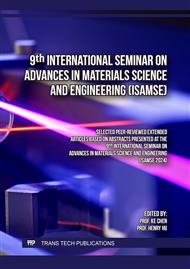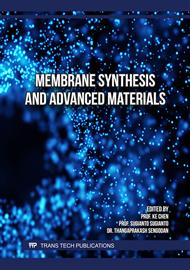[1]
R.O. Ritchie, The conflicts between strength and toughness, Nat. Mater. 10 (2011) 817-822.
Google Scholar
[2]
S.R. Bakshi, D. Lahiri, A. Agarwal, Carbon nanotube reinforced metal matrix composites - a review, Int. Mater. Rev. 55 (2010) 41-64.
DOI: 10.1179/095066009x12572530170543
Google Scholar
[3]
P.J. Withers, M. Preuss, Fatigue and damage in structural materials studied by X-ray tomography, Annual Review of Materials Research. 42 (2012) 81-103.
DOI: 10.1146/annurev-matsci-070511-155111
Google Scholar
[4]
Z.W. Ma, Y. Ren, R.G. Li, Y.D. Wang, L.L. Zhou, X.L. Wu, Y.J. Wei, H.J. Gao, Cryogenic temperature toughening and strengthening due to gradient phase structure, Mater. Sci. Eng. A-Struct. Mater. Prop. Microstruct. Process. 712 (2018) 358-364.
DOI: 10.1016/j.msea.2017.11.107
Google Scholar
[5]
Y. Wei, Y. Li, L. Zhu, Y. Liu, X. Lei, G. Wang, Y. Wu, Z. Mi, J. Liu, H. Wang, Evading the strength–ductility trade-off dilemma in steel through gradient hierarchical nanotwins, Nat. Commun. 5 (2014) 3580.
DOI: 10.1038/ncomms4580
Google Scholar
[6]
S.H. Jiang, H. Wang, Y. Wu, X.J. Liu, H.H. Chen, M.J. Yao, B. Gault, D. Ponge, D. Raabe, A. Hirata, M.W. Chen, Y.D. Wang, Z.P. Lu, Ultrastrong steel via minimal lattice misfit and high-density nanoprecipitation, Nature. 544 (2017) 460-464.
DOI: 10.1038/nature22032
Google Scholar
[7]
S.H. Kim, H. Kim, N.J. Kim, Brittle intermetallic compound makes ultrastrong low-density steel with large ductility, Nature. 518 (2015) 77-79.
DOI: 10.1038/nature14144
Google Scholar
[8]
Y. Jiao, L.J. Huang, T.B. Duan, S.L. Wei, B. Kaveendran, L. Geng, Controllable two-scale network architecture and enhanced mechanical properties of (Ti5Si3+TiBw)/Ti6Al4V composites, Sci Rep. 6 (2016) 10.
DOI: 10.1038/srep32991
Google Scholar
[9]
S. Tammas-Williams, I. Todd, Design for additive manufacturing with site-specific properties in metals and alloys, Scr. Mater. 135 (2017) 105-110.
DOI: 10.1016/j.scriptamat.2016.10.030
Google Scholar
[10]
Z.Y. Liu, K. Ma, G.H. Fan, K. Zhao, J.F. Zhang, B.L. Xiao, Z.Y. Ma, Enhancement of the strength-ductility relationship for carbon nanotube/Al-Cu-Mg nanocomposites by material parameter optimisation, Carbon. 157 (2020) 602-613.
DOI: 10.1016/j.carbon.2019.10.080
Google Scholar
[11]
M.Y. Zhang, N. Zhao, Q. Yu, Z.Q. Liu, R.T. Qu, J. Zhang, S.J. Li, D.C. Ren, F. Berto, Z.F. Zhang, R.O. Ritchie, On the damage tolerance of 3-D printed Mg-Ti interpenetrating-phase composites with bioinspired architectures, Nat. Commun. 13 (2022) 13.
DOI: 10.1038/s41467-022-30873-9
Google Scholar
[12]
R.P. Wilkerson, B. Gludovatz, J. Watts, A.P. Tomsia, G.E. Hilmas, R.O. Ritchie, A study of size effects in bioinspired, "nacre-like", metal-compliant phase (nickel-alumina) coextruded ceramics, Acta Mater. 148 (2018) 147-155.
DOI: 10.1016/j.actamat.2018.01.046
Google Scholar
[13]
E. Lin, Y.N. Li, C. Ortiz, M.C. Boyce, 3D printed, bio-inspired prototypes and analytical models for structured suture interfaces with geometrically-tuned deformation and failure behavior, J. Mech. Phys. Solids. 73 (2014) 166-182.
DOI: 10.1016/j.jmps.2014.08.011
Google Scholar
[14]
Y.M. Zhang, H.M. Yao, C. Ortiz, J.Q. Xu, M. Dao, Bio-inspired interfacial strengthening strategy through geometrically interlocking designs, J. Mech. Behav. Biomed. Mater. 15 (2012) 70-77.
DOI: 10.1016/j.jmbbm.2012.07.006
Google Scholar
[15]
X. Gao, X. Zhang, X., M. Qian, F., A. Li, B., L. Geng, H. Peng, X., Development of Finite Element Modeling Technique for Metal Matrix Composites with Tailored Architectures, Mater. China. 39 (2020) 13.
Google Scholar
[16]
Y.F. Sun, Y. Chen, N. Tsuji, S. Guan, Microstructural evolution and mechanical properties of nanostructured Cu/Ni multilayer fabricated by accumulative roll bonding, J. Alloy. Compd. 819 (2020) 10.
DOI: 10.1016/j.jallcom.2019.152956
Google Scholar
[17]
Y.C. Wang, F. Liang, H.F. Tan, B. Zhang, G.P. Zhang, Enhancing fatigue strength of high-strength ultrafine-scale Cu/Ni laminated composites, Mater. Sci. Eng. A-Struct. Mater. Prop. Microstruct. Process. 714 (2018) 43-48.
DOI: 10.1016/j.msea.2017.12.097
Google Scholar
[18]
A.L. Gurson, Continuum theory of ductile rupture by void nucleation and growth: Part I—Yield criteria and flow rules for porous ductile media, J. Eng. Mater. Technol.-Trans. ASME. 99 (1977) 2-15.
DOI: 10.2172/7351470
Google Scholar
[19]
V. Tvergaard, Influence of voids on shear band instabilities under plane strain conditions, Int. J. Fract. 17 (1981) 389-407.
DOI: 10.1007/bf00036191
Google Scholar
[20]
V. Tvergaard, On localization in ductile materials containing spherical voids, Int. J. Fract. 18 (1982) 237-252.
DOI: 10.1007/bf00015686
Google Scholar
[21]
V. Tvergaard, A. Needleman, Analysis of the cup-cone fracture in a round tensile bar, Acta Metallurgica. 32 (1984) 157-169.
DOI: 10.1016/0001-6160(84)90213-x
Google Scholar
[22]
G. Branko, G. Shephard, 1987. Tilings and Patterns, New York.
Google Scholar
[23]
V.S. Deshpande, M.F. Ashby, N.A. Fleck, Foam topology bending versus stretching dominated architectures, Acta Mater. 49 (2001) 1035-1040.
DOI: 10.1016/s1359-6454(00)00379-7
Google Scholar
[24]
Y. Kim, Y. Kim, F. Libonati, S. Ryu, Designing tough isotropic structural composite using computation, 3D printing and testing, Compos. Pt. B-Eng. 167 (2019) 736-745.
DOI: 10.1016/j.compositesb.2019.03.039
Google Scholar



